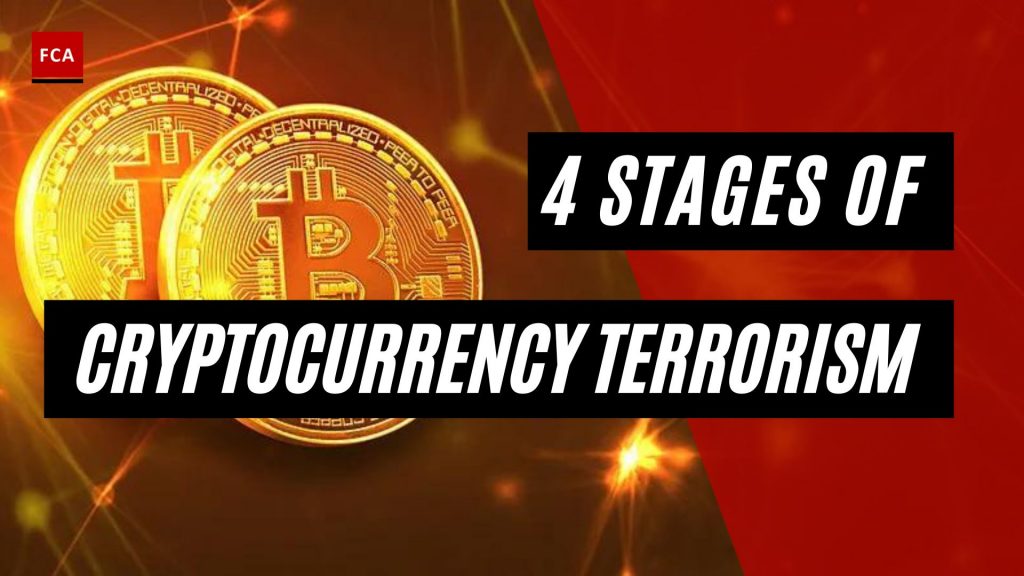The 4 stages of cryptocurrency terrorism. The process of how terrorists use their financing can be explained in different stages. Simply put, the process of terrorist financing follows a four-stage approach. These four stages are Collecting, Storing, Moving, and Using. Essentially, the application of blockchain technology and the use of cryptocurrencies happens alongside these stages.

4 Stages Of Cryptocurrency Terrorism: The Cryptocurrency Terrorist Financing Stages
Terrorist organizations and even individual terrorists and insurgents require financial support. This money is generated by either lawful or unlawful means and is usually transferred through illegal means like money laundering, making it another form of financial crime. Terrorist financing using cryptocurrencies follows four stages: Collecting, Storing, Moving, and Using.
Stage 1: Collecting
The first stage, the collecting stage, refers to the generation of the funds intended for a terrorist or terror organization. The most common sources of terrorist funding are state sponsorship, charitable or personal donations, illegal activities, and legal business activities. Illegal activities include drug trafficking and other smuggling, fraud, extortion, and petty crime. Legal activities include salaried employment, legitimate businesses, and personal or credit-based loans.
A terrorist group’s choice of source varies significantly according to availability and group preferences and may evolve. The success of intelligence and law enforcement agencies in constraining the ability of terrorist groups to raise money can lead terrorist organizations to search for alternative fundraising methods, which in turn leads authorities to develop new countermeasures.
For example, ISIS previously generated almost all of its funding from its control of territory. The funding sources for ISIS included taxation, sale of natural resources such as oil, appropriation of government assets in ISIS-controlled territory, and looting of historical artifacts, cars, and anything else they confiscated. ISIS engaged in little fundraising or illegal fundraising activities outside its territory. More recently, however, ISIS started mimicking al Qaeda and has shifted toward illegal fundraising activities.
Now concerning cryptocurrencies, they might support terrorists by receiving funding through various means. For example, many supporters of terrorist organizations have not been donating as much to terrorist groups as they did in the past because of increased legal and financial risks. But with a cryptocurrency, which is robust, secure, and anonymous, this could re-enable donations as a significant source of terrorist financing. Supporters might donate their cryptocurrencies or use cryptocurrencies to transfer funds through broker intermediaries.
In addition, the sale of illegal goods and drug trafficking may be critically assisted by cryptocurrencies. The darknet markets that play a significant role in cryptocurrency economies already make this scenario quite real. Trafficking of goods, especially drugs, is already occurring extensively on darknet markets, and terrorist groups are involved. However, the extent to which terrorist organizations are currently involved is unclear because these darknet markets are not yet used heavily in the areas of the world where terrorist groups engage in drug trafficking.

Stage 2: Storming
The second stage is the storming stage. Once funds are generated, terrorist organizations must store and manage the money. To understand this, put yourself in the shoes of a fundraiser of a terrorist organization for a moment. You have received some money from direct donations in amounts large and small, given by individuals, legal entities, non-profit organizations, or businesses, and, in some cases, foreign countries. What do you do with this? You bundle it to make it easier to handle and store.
Fund-storing can be accomplished through means such as Bank and other accounts, Pre-paid cards, high-value commodities such as oil, art and antiquities, agricultural products, precious metals and gems, and even used vehicles.
Concerning cryptocurrencies, terrorist organizations may store their coins in various wallets. They store the funds until they have determined and planned for their use.
However, storing and managing cryptocurrency funds can be quite challenging for them. Large terrorist organizations often rely on relatively sophisticated financial infrastructure with multiple levels of management, reporting, accounting, and financial planning. Especially terrorist organizations under attack, like ISIS, must pay attention to the robustness of their financial systems to limit or prevent losses of personnel, sites, or records.
Stage 3: Moving
The third stage is moving the funds. When the terror group has as many funds as required and an operational need, they move funds from the store to somewhere else. If the money received is not yet under the direct control of the terrorist organization or if it cannot be transferred because of operational security concerns, they use money laundering and other transfer mechanisms.
It is more critical for groups that rely on external funding and less critical for primarily territorial groups, such as ISIS, which have few external sources of funds. For example, Hezbollah relies more heavily on state sponsorship and has access to banking systems in Iran and Libya, while al Qaeda and affiliates generally must use other methods.
Useful ways in which terrorist organizations transfer money includes cash couriers, informal transfer systems, money service businesses, formal banking, false trade invoicing, and high-value commodities.
Although these are important to terrorist organizations, transaction volume is particularly critical because most transactions occur within a few specific countries and are either internal fund transfers or settlements between known parties. Large transactions may therefore be difficult and noticeable.
Such transactions create an opportunity for cryptocurrencies. However, there is a certain trade-off involved. Let’s consider Bitcoin as an example. For Bitcoin, there is a trade-off between volume, cost, risk, and speed. Large fund transfers via Bitcoin that occur quickly would require the purchase of enough Bitcoin, which might be noticeable by authorities, creating risk, and would change market prices, increasing costs.
Other cryptocurrencies can offer more anonymity but might be smaller in volume than Bitcoin. So what terrorists would need to do is to move funds in smaller amounts and incrementally.
But essentially, moving the funds with cryptocurrencies is quite convenient once a terrorist organization has reached technological sophistication.

Stage 4: Using
Finally, terrorist groups use the funds they have collected. We can differentiate between operating costs and costs to produce violence for our purposes. The exact mechanisms typically fund both categories.
Different terrorist groups will budget differently based on their needs and goals, and the operations to track and disrupt the activities of such groups will have different effects, depending on the choices made. It is challenging to separate licit operations and expenses, such as salaries and social services, from clearly illicit spending, such as terrorism recruitment and training. For example, operating costs, such as propaganda, recruitment, salaries, and social services, indirectly contribute to an organization’s ability to produce violence.
The use of funds by terrorist groups is more difficult now than in the past, largely because of counter-terrorist financing operations, potentially making alternatives like cryptocurrency more tempting for these groups.
Most terrorist groups are currently constrained in their ability to use cryptocurrency because of the limited acceptability and usability of these currencies in the regions where terrorist groups operate. Even if a group receives and manages these funds, they cannot easily be used to pay for expenses where vendors and members expect cash, either in stable currencies like dollars and euros or in local currencies. For instance, few Bitcoin ATMs exist in the Middle East, making it difficult to exchange Bitcoins for fiat currencies. Bitcoin ATMs tend to be more prevalent in Europe and the United States, where local banking and currency laws deter illicit use.
The potential critical exception is direct operational costs for overseas attacks by affiliates of the al Qaeda network or independent cells like those inspired by ISIS. Most cells in Europe and North America appear to be self-financed, and many centrally directed cells are partially self-financed because most attacks have been relatively cheap. The significant majority of attacks in Western countries have cost less than 10,000 US Dollars, which is, unsurprisingly, the bank reporting threshold for suspicious activities in many Western countries.
Final Thoughts
Understanding the 4 stages of cryotocurrency terrorist financing is extremely beneficial. Countries should take a cautious approach. They should ensure that their law enforcement agencies have the resources and skills needed to investigate related illicit activity, and they should work to improve information sharing with their foreign counterparts on joint investigations.
Limited efforts to regulate specific cryptocurrency service providers, such as cryptocurrency exchanges, represent a reasonable first step toward oversight. Before taking further action, countries should monitor and assess the effectiveness of new regulations.








